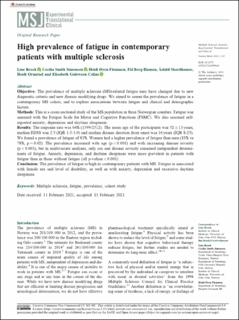| dc.contributor.author | Broch, Line | |
| dc.contributor.author | Simonsen, Cecilia Smith | |
| dc.contributor.author | Flemmen, Heidi Øyen | |
| dc.contributor.author | Berg-Hansen, Pål | |
| dc.contributor.author | Skardhamar, Åshild | |
| dc.contributor.author | Ormstad, Heidi | |
| dc.contributor.author | Celius, Elisabeth Gulowsen | |
| dc.date.accessioned | 2022-02-24T12:38:24Z | |
| dc.date.available | 2022-02-24T12:38:24Z | |
| dc.date.created | 2021-04-08T12:13:08Z | |
| dc.date.issued | 2021 | |
| dc.identifier.citation | Broch, L., Simonsen, C. S., Flemmen, H. Ø., Berg-Hansen, P., Skardhamar, Å., Ormstad, H. & Celius, E. G. (2021). High prevalence of fatigue in contemporary patients with multiple sclerosis. Multiple Sclerosis Journal - Experimental, Translational and Clinical, 7(1), 1-10. | en_US |
| dc.identifier.issn | 2055-2173 | |
| dc.identifier.uri | https://hdl.handle.net/11250/2981259 | |
| dc.description.abstract | Objective: The prevalence of multiple sclerosis (MS)-related fatigue may have changed due to new diagnostic criteria and new disease modifying drugs. We aimed to assess the prevalence of fatigue in a contemporary MS cohort, and to explore associations between fatigue and clinical and demographic factors.
Methods: This is a cross-sectional study of the MS population in three Norwegian counties. Fatigue was assessed with the Fatigue Scale for Motor and Cognitive Functions (FSMC). We also assessed self-reported anxiety, depression and daytime sleepiness.
Results: The response rate was 64% (1599/2512). The mean age of the participants was 52 ± 13 years, median EDSS was 2.5 (IQR 1.5-3.0) and median disease duration from onset was 16 years (IQR 8-25). We found a prevalence of fatigue of 81%. Women had a higher prevalence of fatigue than men (83% vs 78%, p = 0.02). The prevalence increased with age (p < 0.001) and with increasing disease severity (p < 0.001), but in multivariate analyses, only sex and disease severity remained independent determinants of fatigue. Anxiety, depression, and daytime sleepiness were more prevalent in patients with fatigue than in those without fatigue (all p-values < 0.001).
Conclusion: The prevalence of fatigue is high in contemporary patients with MS. Fatigue is associated with female sex and level of disability, as well as with anxiety, depression and excessive daytime sleepiness. | en_US |
| dc.language.iso | eng | en_US |
| dc.rights | Navngivelse-Ikkekommersiell 4.0 Internasjonal | * |
| dc.rights.uri | http://creativecommons.org/licenses/by-nc/4.0/deed.no | * |
| dc.title | High prevalence of fatigue in contemporary patients with multiple sclerosis | en_US |
| dc.type | Peer reviewed | en_US |
| dc.type | Journal article | en_US |
| dc.description.version | publishedVersion | en_US |
| dc.rights.holder | © The Author(s), 2021. | en_US |
| dc.source.pagenumber | 10 | en_US |
| dc.source.volume | 7 | en_US |
| dc.source.journal | Multiple Sclerosis Journal, Experimental, Translational and Clinical | en_US |
| dc.source.issue | 1 | en_US |
| dc.identifier.doi | https://doi.org/10.1177/2055217321999826 | |
| dc.identifier.cristin | 1902943 | |
| cristin.ispublished | true | |
| cristin.fulltext | original | |
| cristin.qualitycode | 1 | |

